Bastet › Ancient Egyptian Culture » Ancient origins
Articles and Definitions › Contents
- Bastet › Who Was
- Ancient Egyptian Culture › Antique Origins
Ancient civilizations › Historical and archaeological sites
Bastet › Who Was
Definition and Origins
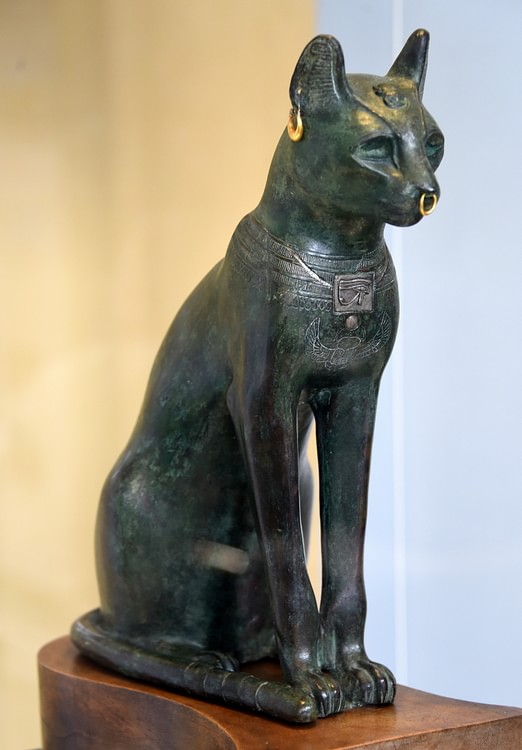
Bastet is the Egyptian goddess of the home, domesticity, women's secrets, cats, fertility, and childbirth. She protected the home from evil spirits and disease, especially diseases associated with women and children. As with many Egyptian deities, she also played a role in the afterlife as a guide and helper to the dead although this was not one of her primary duties. She was the daughter of the sun god Ra and is associated with the concept of the Eye of Ra (the all-seeing eye) and the Distant Goddess (a female deity who leaves Ra and returns to bring transfromation).
MEANING OF BASTET'S NAME
Her name was originally B'sst which became Ubaste, then Bast, then Bastet; the meaning of this name is not known or, at least, not universally agreed upon. Geraldine Pinch claims that "her name probably means She of the Ointment Jar" as she was associated with protection and protective ointments (115). The Greeks associated her closely with their goddess Artemisand believed that, as Artemis had a twin brother ( Apollo ) so should Bast. They associated Apollo with Horus, the son of Isis(Heru-sa-Aset) and so called the goddess known as Bast ba'Aset (Soul of Isis) which would be the literal translation of her name with the addition of the second 'T' to denote the feminine (Aset being among the Egyptian names for Isis).
Bastet, however, was also sometimes linked with the god of perfume and sweet smells, Nefertum, who was thought to be her son and this further links the meaning of her name to the ointment jar. The most obvious understanding would be that, originally, the name meant something like She of the Ointment Jar (Ubaste) and the Greeks changed the meaning to Soul of Isis as they associated her with the most popular goddess in Egypt. Even so, scholars have come to no agreement on the meaning of her name.

Bastets & Sekhmets
ASSOCIATIONS
Bastet was extremely popular throughout Egypt with both men and women from the 2nd Dynasty (c. 2890 - c. 2670 BCE) onward with her cult centered at the city of Bubastis from at least the 5th century BCE. She was first represented as a woman with the head of a lioness and closely associated with the goddess Sekhmet but, as that deity's iconography depicted her as increasingly aggressive, Bastet's images softened over time to present more of a daily companion and helper than her earlier forms as savage avenger. Scholar Geraldine Pinch writes:
From the Pyramid Texts onward, Bastet has a double aspect of nurturing mother and terrifying avenger. It is the demonic aspect that mainly features in the Coffin Texts and the Book of the Dead and in medical spells. The "slaughterers of Bastet" were said to inflict plague and other disasters on humanity. One spell advises pretending to be the 'son of Bastet' in order to avoid catching the plague (115).
BASTET IS SOMETIMES RENDERED IN ART WITH A LITTER OF KITTENS AT HER FEET BUT HER MOST POPULAR DEPICTION IS OF A SITTING CAT GAZING AHEAD.
Although she was greatly venerated, she was equally feared as two of her titles demonstrate: The Lady of Dread and The Lady of Slaughter. She is associated with both Mau, the divine cat who is an aspect of Ra, and with Mafdet, goddess of justice and the first feline deity in Egyptian history. Both Bastet and Sekhment took their early forms as feline defenders of the innocent, avengers of the wronged, from Mafdet. This association was carried on in depictions of Bastet's son Maahes, protector of the innocent, who is shown as a lion-headed man carrying a long knife or as a lion.
In Bastet's association with Mau, she is sometimes seen destroying the enemy of Ra, Apophis, by slicing off his head with a knife in her paw; an image Mau is best known by. In time, as Bastet became more of a familial companion, she lost all trace of her lionine form, and was regularly depicted as a house cat or a woman with the head of a cat often holding a sistrum. She is sometimes rendered in art with a litter of kittens at her feet but her most popular depiction is of a sitting cat gazing ahead.
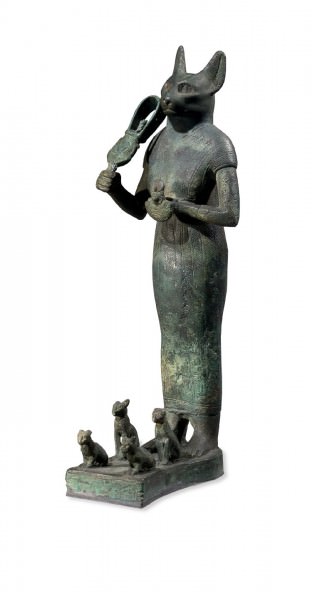
Bastet
ROLE IN RELIGION & ICONOGRAPHY
Bastet appears early in the 3rd millenium BCE in her form as an avenging lioness in Lower Egypt. By the time of the Pyramid Texts (c. 2400-2300 BCE) she was associated with the king of Egypt as his nursemaid in youth and protector as he grew. In the later Coffin Texts (c. 2134-2040 BCE) she retains this role but is also seen as a protector of the dead. The scholar Richard H. Wilkinson comments on this:
In her earliest known form, as depicted on stone vessels of the 2nd dynasty, Bastet was represented as a woman with the maneless head of a lioness. The iconography of the goddess changed, however, perhaps as her nature began to be viewed as milder than that of other lioness deities (178).
Her cult center at Bubastis in Lower Egypt became one of the richest and most luxuriant cities in Egypt as people from all over the country traveled there to pay their respects to the goddess and have the bodies of their dead cats interred in the city. Her iconography borrowed from the earlier goddess Mafdet and also from Hathor, a goddess associated with Sekhmet who was also closely linked to Bastet. The appearance of the sistrum in Bastet's hand in some statues is a clear link to Hathor who is traditionally seen carrying the instrument. Hathor is another goddess who underwent a dramatic change from bloodthirsty destroyer to gentle friend of humanity as she was originally the lioness deity Sekhmet whom Ra sent to earth to destroy humans for their sins. In Bastet's case, although she became more mild, she was no less dangerous to those who broke the law or abused others.
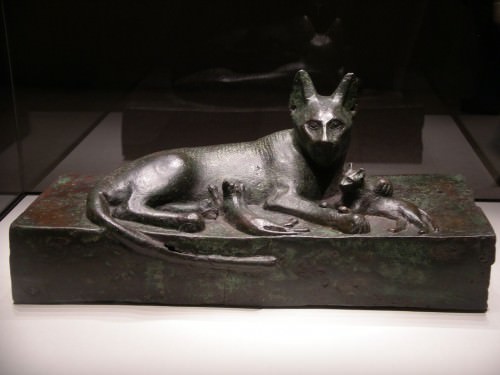
Egyptian Cat
THE TALE OF SETNA & TABOUBU
The Tale of Setna and Taboubu (part of the work known as First Setna or Setna I) is the middle section of a work of Egyptian literature composed in the Roman Period of Egypt's history and currently held by the Cairo Museum in Egypt. The main character of the Setna tales is Prince Setna Khaemwas who is based on the actual prince and High Priest of Ptah Khaemweset (c. 1281 - c.1225 BCE) the son of Ramesses II. Khaemweset, known as the "First Egyptologist", was famous for his restoration and preservation efforts of ancient Egyptian monuments and, by the time of the Ptolemaic Period, was greatly revered as a sage and magician. Although the story may be interpreted in many different ways, Geraldine Pinch argues that this section of the tale can most clearly be understood as an illustration of how Bastet punishes transgressors.
In this story young Prince Setna steals a book from a tomb, even after the inhabitants of the tomb beg him not to. Shortly afterwards he is in Memphis, near the Temple of Ptah, when he sees a beautiful woman accompanied by her servants and lusts after her. He asks about her and learns her name is Taboubu, daughter of a priest of Bastet. He has never seen any woman more beautiful in his life and sends her a note asking her to come to his bed for ten gold pieces but she returns a counter-offer telling him to meet her at the Temple of Bastet in Saqqara where she lives and he will then have all he desires.
Setna travels to her villa where he is eager to get to the business at hand but Taboubu has some stipulations. First, she tells him, he must sign over all his property and possessions to her. He is so consumed with lust that he agrees to this and moves to embrace her. She holds him off, however, and tells him that his children must be sent for and must also sign the documents agreeing to this so that there will be no problems with the legal transference. Setna agrees to this also and sends for his children. While they are signing the papers Taboubu disappears into another room and returns wearing a linen dress so sheer that he can see "every part of her body through it" and his desire for her grows almost uncontrollable. With the documents signed he again moves toward her but, no, she has a third demand: his children must be killed so that they will not try to renege on the agreement and embroil her in a long, drawn-out court battle. Setna instantly agrees to this; his children are murdered and their bodies thrown into the street. Setna then pulls off his clothes, takes Taboubu, and leads her quickly to the bedroom. As he is embracing her she suddenly screams and vanishes - as does the room and villa around them - and Setna is standing naked in the street with his penis thrust into a clay pot.
The pharaoh comes by at this time and Prince Setna is completely humiliated. Pharaoh informs him that his children still live and that everything he has experienced has been an illusion. Setna then understands he has been punished for his transgression in the tomb and quickly returns the book. He further makes restitution to the inhabitants of the tomb by traveling to another city and retrieving mummies buried there who were part of the tomb inhabitant's family so they can all be reunited in one place.
Although scholars disagree on who Taboubu represents, her close association with Bastet as the daughter of one of the goddesses' priests makes this deity a very likely candidate. The predatory nature of Taboubu, once she has Setna where she wants him, is reminiscent of the cat toying with the mouse. Geraldine Pinch concludes that Taboubu is a "manifestation of Bastet herself, playing her traditional role of punisher of humans who have offended the gods" (117). In this story Bastet takes on the form of a beautiful woman to punish a wrong-doer who had violated a tomb but the story would also have been cautionary to men who viewed women only as sexual objects in that they could never know whether they were actually in the presence of a goddess and what might happen should they offend her.
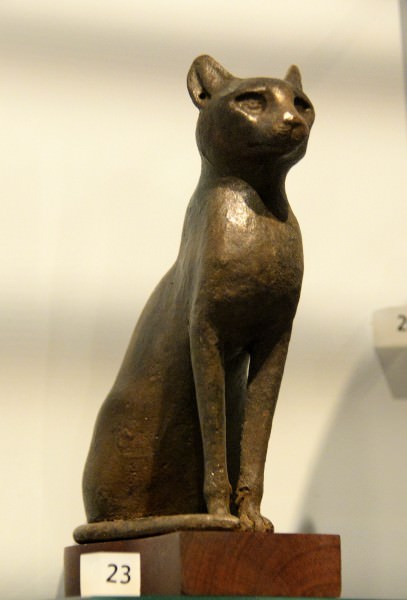
Bronze Cat from Egypt
WORSHIP OF BASTET
The goddess was worshipped primarily at Bubastis but held a tutelary position at Saqqara and elsewhere. Wilkinson writes:
The goddess's popularity grew over time and in the Late Period and Graeco-Roman times she enjoyed great status. The main cult centre of this deity was the city of Bubastis - Tell Basta - in the eastern Delta, and although only the outlines of the temple of Bastet now remain, Herodotus visited the site in the 5th century BC and praised it for its magnificence. The festival of Bastet was also described by Herodotus who claimed it was the most elaborate of all the religious festivals of Egypt with large crowds participating in unrrestrained dancing, drinking, and revelry (178).
Herodotus is the primary source for information on the cult of Bastet and, unfortunately, does not go into great detail on the particulars of her worship. It seems both men and women served as her clergy and, as with the other Egyptian deities, her temple at Bubastis was the focal point of the city providing services ranging from medical attention to counseling to food distribution. Herodotus describes this temple:
Save for the entrance, it stands on an island; two separate channels approach it from the Nile, and after coming up to the entry of the temple, they run round it on opposite sides; each of them a hundred feet wide, and overshadowed by trees. The temple is in the midst of the city, the whole circuit of which commands a view down into it; for the city's level has been raised, but that of the temple has been left as it was from the first, so that it can be seen into from without. A stone wall, carven with figures, runs round it; within is a grove of very tall trees growing round a great shrine, wherein is the image of the goddess; the temple is a square, each side measuring a furlong. A road, paved with stone, of about three furlongs' length leads to the entrance, running eastward through the market place, towards the temple of Hermes ; this road is about 400 feet wide, and bordered by trees reaching to heaven. (Histories, II.138).
The people of Egypt came annually to the great festival of Bastet at Bubastis which was one of the most lavish and popular events of the year. Geraldine Pinch, citing Herodotus, claims, "women were freed from all constraints during the annual festival at Bubastis. They celebrated the festival of the goddess by drinking, dancing, making music, and displaying their genitals" (116). This "raising of the skirts" by the women, described by Herodotus, had as much to do with freedom from social constraints as it did with the fertility associated with the goddess. As with many of the other festivals throughout Egypt, Bastet's celebration was a time to cast aside inhibitions much in the way modern revelers do in Europe during Carnivale or in the United States at Mardi Gras. Herodotus presents a vivid picture of the people traveling to Bubastis for the festival:
When the people are on their way to Bubastis, they go by river, a great number in every boat, men and women together. Some of the women make a noise with rattles, others play flutes all the way, while the rest of the women, and the men, sing and clap their hands. As they travel by river to Bubastis, whenever they come near any other town they bring their boat near the bank; then some of the women do as I have said, while some shout mockery of the women of the town; others dance, and others stand up and lift their skirts. They do this whenever they come alongside any riverside town. But when they have reached Bubastis, they make a festival with great sacrifices, and more wine is drunk at this feast than in the whole year besides. It is customary for men and women (but not children) to assemble there to the number of seven hundred thousand, as the people of the place say ( Histories, Book II.60).
Although Herodotus claims that this festival outstripped all others in magnificence and excess, in reality there were many festivals celebrating many gods which could claim the same. The popularity of this goddess, however, made her celebration of particular significance. In the passage above, Herodotus makes note of how the women in the boats mocked those on shore and this would have been done to encourage them to leave off their daily tasks and join the celebration of the great goddess.Bastet, in fact, was second only to Isis in popularity and, once she traveled through Greece to Rome, was equally popular among the Romans and the subjects of their later empire.
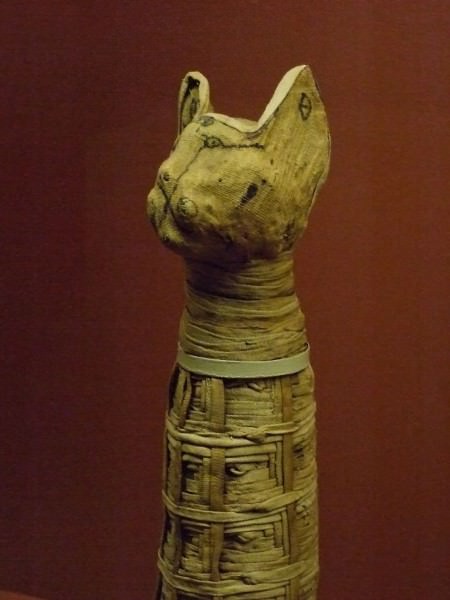
Cat Mummy
BASTET'S ENDURING POPULARITY
The popularity of Bastet grew from her role as protector of women and the household. As noted, she was as popular among men as women in that every man had a mother, sister, girlfriend, wife, or daughter who benefited from the care Bastet provided. Further, women in Egypt were held in high regard and had almost equal rights which almost guaranteed a goddess who protected women and presided over women's secrets an especially high standing. Cats were also greatly prized in Egypt as they kept homes free of vermin (and so controlled diseases), protected the crops from unwanted animals, and provided their owners with fairly maintenance-free company. One of the most important aspects of Bastet's festival was the delivery of mummified cats to her temple. When the temple was excavated in 1887 and 1889 CE over 300,000 mummified cats were found. Wilkinson, commenting on her universal popularity, writes:
Amulets of cats and litters of kittens were popular New Year gifts, and the name of Bastet was often inscribed on small ceremonial `New Year flasks', probably to evoke the goddess as a bestower of fertility and because Bastet, like other lioness goddesses, was viewed as a protective deity able to counter the darker forces associated with the `Demon Days' at the end of the Egyptian year (178).
Bastet was so popular that, in 525 BCE, when Cambyses II of Persia invaded Egypt, he made use of the goddess to force the Egyptian's surrender. Knowing of their great love for animals, and cats especially, he had his soldiers paint the image of Bastet on their shields and then arranged all the animals that could be found and drove them before the army toward the pivotal city of Pelusium. The Egyptians refused to fight for fear of harming the animals and offending Bastet and so surrendered. The historian Polyaenus (2nd century CE) writes how, after his victory, Cambyses II hurled cats from a bag into the Egyptian's faces in scorn that they would surrender their city for animals. The Egyptians were undeterred in their veneration of the cat and their worship of Bastet, however. Her status as one of the most popular and potent deities continued throughout the remainder of Egypt's history and on into the era of the Roman Empire until, like the other gods, she was eclipsed by the rise of Christianity.
Ancient Egyptian Culture › Antique Origins
Definition and Origins

Ancient Egyptian culture flourished between c. 5500 BCE with the rise of technology (as evidenced in the glass-work of faience ) and 30 BCE with the death of Cleopatra VII, the last Ptolemaic ruler of Egypt. It is famous today for the great monuments which celebrated the triumphs of the rulers and honored the gods of the land. The culture is often misunderstood as having been obsessed with death but, had this been so, it is unlikely it would have made the significant impression it did on other ancient cultures such as Greece and Rome. The Egyptian culture was, in fact, life affirming, as the scholar Salima Ikram writes:
Judging by the numbers of tombs and mummies that the ancient Egyptians left behind, one can be forgiven for thinking that they were obsessed by death. However, this is not so. The Egyptians were obsessed by life and its continuation rather than by a morbid fascination with death. The tombs, mortuary temples and mummies that they produced were a celebration of life and a means of continuing it for eternity…For the Egyptians, as for other cultures, death was part of the journey of life, with death marking a transition or transformation after which life continued in another form, the spiritual rather than the corporeal. (ix).
This passion for life imbued in the ancient Egyptians a great love for their land as it was thought that there could be no better place on earth in which to enjoy existence. While the lower classes in Egypt, as elsewhere, subsisted on much less than the more affluent, they still seem to have appreciated life in the same way as the wealthier citizens. This is exemplified in the concept of gratitude and the ritual known as The Five Gifts of Hathor in which the poor labourers were encouraged to regard the fingers of their left hand (the hand they reached with daily to harvest field crops) and to consider the five things they were most grateful for in their lives. Ingratitude was considered a `gateway sin' as it led to all other types of negative thinking and resultant behaviour. Once one felt ungrateful, it was observed, one then was apt to indulge oneself further in bad behaviour.The Cult of Hathor was very popular in Egypt, among all classes, and epitomizes the prime importance of gratitude in Egyptian culture.
RELIGION IN ANCIENT EGYPT
Religion was an integral part of the daily life of every Egyptian. As with the people of Mesopotamia, the Egyptians considered themselves co-labourers with the gods but with an important distinction: whereas the Mesopotamian peoples believed they needed to work with their gods to prevent the recurrence of the original state of chaos, the Egyptians understood their gods to have already completed that purpose and a human's duty was to celebrate that fact and give thanks for it. So-called ` Egyptian mythology ' was, in ancient times, as valid a belief structure as any accepted religion in the modern day.
Egyptian religion taught the people that, in the beginning, there was nothing but chaotic swirling waters out of which rose a small hill known as the Ben-Ben. Atop this hill stood the great god Atum who spoke creation into being by drawing on the power of Heka, the god of magic. Heka was thought to pre-date creation and was the energy which allowed the gods to perform their duties. Magic informed the entire civilization and Heka was the source of this creative, sustaining, eternal power.
In another version of the myth, Atum creates the world by first fashioning Ptah, the creator god who then does the actual work.Another variant on this story is that Ptah first appeared and created Atum. Another, more elaborate, version of the creation story has Atum mating with his shadow to create Shu (air) and Tefnut (moisture) who then go on to give birth to the world and the other gods.
From this original act of creative energy came all of the known world and the universe. It was understood that human beings were an important aspect of the creation of the gods and that each human soul was as eternal as that of the deities they revered. Death was not an end to life but a re-joining of the individual soul with the eternal realm from which it had come.
The Egyptian concept of the soul regarded it as being comprised of nine parts: the Khat was the physical body; the Ka one's double-form; the Ba a human-headed bird aspect which could speed between earth and the heavens; Shuyet was the shadow self; Akh the immortal, transformed self, Sahu and Sechem aspects of the Akh ; Ab was the heart, the source of good and evil;Ren was one's secret name.
An individual's name was considered of such importance that an Egyptian's true name was kept secret throughout life and one was known by a nickname. Knowledge of a person's true name gave one magical powers over that individual and this is among the reasons why the rulers of Egypt took another name upon ascending the throne; it was not only to link oneself symbolically to another successful pharaoh but also a form of protection to ensure one's safety and help guarantee a trouble-free journey to eternity when one's life on earth was completed. According to the historian Margaret Bunson:
Eternity was an endless period of existence that was not to be feared by any Egyptian. The term `Going to One's Ka' (astral being) was used in each age to express dying. The hieroglyph for a corpse was translated as `participating in eternal life'. The tomb was the `Mansion of Eternity' and the dead was an Akh, a transformed spirit. (86).
The famous Egyptian mummy (whose name comes from the Persian and Arabic words for `wax' and `bitumen', muum and mumia ) was created to preserve the individual's physical body ( Khat ) without which the soul could not achieve immortality.As the Khat and the Ka were created at the same time, the Ka would be unable to journey to The Field of Reeds if it lacked the physical component on earth. The gods who had fashioned the soul and created the world consistently watched over the people of Egypt and heard and responded to, their petitions. A famous example of this is when Ramesses II was surrounded by his enemies at the Battle of Kadesh (1274 BCE) and, calling upon the god Amun for aid, found the strength to fight his way through to safety. There are many far less dramatic examples, however, recorded on temple walls, stele, and on papyrus fragments.
CULTURAL ADVANCES & DAILY LIFE
Papyrus (from which comes the English word `paper') was only one of the technological advances of the ancient Egyptian culture. The Egyptians were also responsible for developing the ramp and lever and geometry for purposes of construction, advances in mathematics and astronomy (also used in construction as exemplified in the positions and locations of the pyramids and certain temples, such as Abu Simbel ), improvements in irrigation and agriculture (perhaps learned from the Mesopotamians), ship building and aerodynamics (possibly introduced by the Phoenicians ) the wheel (brought to Egypt by the Hyksos ) and medicine.
The Kahun Gynaecological Papyrus (c. 1800 BCE) is an early treatise on women's health issues and contraception and the Edwin Smith Papyrus (c. 1600 BCE) is the oldest work on surgical techniques. Dentistry was widely practised and the Egyptians are credited with inventing toothpaste, toothbrushes, the toothpick, and even breath mints. They created the sport of bowling and improved upon the brewing of beer as first practised in Mesopotamia. The Egyptians did not, however, invent beer. This popular fiction of Egyptians as the first brewers stems from the fact that Egyptian beer more closely resembled modern-day beer than that of the Mesopotamians.
Glass working, metallurgy in both bronze and gold, and furniture were other advancements of Egyptian culture and their art and architecture are famous world-wide for precision and beauty. Personal hygiene and appearance was valued highly and the Egyptians bathed regularly, scented themselves with perfume and incense, and created cosmetics used by both men and women. The practice of shaving was invented by the Egyptians as was the wig and the hairbrush.
By 1600 BCE the water clock was in use in Egypt, as was the calendar. Some have even suggested that they understood the principle of electricity as evidenced in the famous Dendera Light engraving on the wall of the Hathor Temple at Dendera. The images on the wall have been interpreted by some to represent a light bulb and figures attaching said bulb to an energy source. This interpretation, however, has been largely discredited by the academic community.
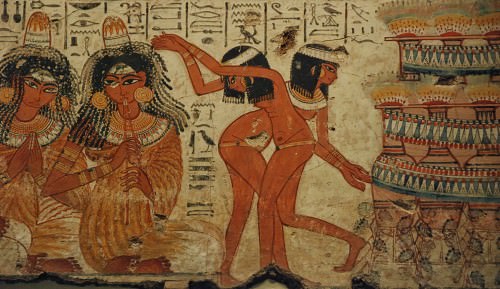
Ancient Egyptian Music and Dancing
In daily life, the Egyptians seem little different from other ancient cultures. Like the people of Mesopotamia, India, China, and Greece, they lived, mostly, in modest homes, raised families, and enjoyed their leisure time. A significant difference between Egyptian culture and that of other lands, however, was that the Egyptians believed the land was intimately tied to their personal salvation and they had a deep fear of dying beyond the borders of Egypt. Those who served their country in the army, or those who travelled for their living, made provision for their bodies to be returned to Egypt should they be killed. It was thought that the fertile, dark earth of the Nile River Delta was the only area sanctified by the gods for the re-birth of the soul in the afterlife and to be buried anywhere else was to be condemned to non-existence.
Because of this devotion to the homeland, Egyptians were not great world-travellers and there is no `Egyptian Herodotus ' to leave behind impressions of the ancient world beyond Egyptian borders. Even in negotiations and treaties with other countries, Egyptian preference for remaining in Egypt was dominant. The historian Nardo writes,
Though Amenophis III had joyfully added two Mitanni princesses to his harem, he refused to send an Egyptian princess to the sovereign of Mitanni, because, `from time immemorial a royal daughter from Egypt has been given to no one.' This is not only an expression of the feeling of superiority of the Egyptians over the foreigners but at the same time and indication of the solicitude accorded female relatives, who could not be inconvenienced by living among `barbarians'. (31)
Further, within the confines of the country people did not travel far from their places of birth and most, except for times of war, famine or other upheaval, lived their lives and died in the same locale. As it was believed that one's afterlife would be a continuation of one's present (only better in that there was no sickness, disappointment or, of course, death), the place in which one spent one's life would constitute one's eternal landscape. The yard and tree and stream one saw every day outside one's window would be replicated in the afterlife exactly. This being so, Egyptians were encouraged to rejoice in and deeply appreciate their immediate surroundings and to live gratefully within their means. The concept of ma'at (harmony and balance) governed Egyptian culture and, whether of upper or lower class, Egyptians endeavoured to live in peace with their surroundings and with each other.
CLASS DISTINCTIONS IN EGYPTIAN CULTURE
Among the lower classes, homes were built of mud bricks baked in the sun. The more affluent a citizen, the thicker the home;wealthier people had homes constructed of a double layer, or more, of brick while poorer people's houses were only one brick wide. Wood was scarce and was only used for doorways and window sills (again, in wealthier homes) and the roof was considered another room in the house where gatherings were routinely held as the interior of the homes were often dimly lighted.
Clothing was simple linen, un-dyed, with the men wearing a knee-length skirt (or loincloth) and the women in light, ankle-length dresses or robes which concealed or exposed their breasts depending on the fashion at a particular time. It would seem that a woman's level of undress, however, was indicative of her social status throughout much of Egyptian history. Dancing girls, female musicians, and servants and slaves are routinely shown as naked or nearly naked while a lady of the house is fully clothed, even during those times when exposed breasts were a fashion statement.
Even so, women were free to dress as they pleased and there was never a prohibition, at any time in Egyptian history, on female fashion. A woman's exposed breasts were considered a natural, normal, fashion choice and was in no way deemed immodest or provocative. It was understood that the goddess Isis had given equal rights to both men and women and, therefore, men had no right to dictate how a woman, even one's own wife, should attire herself. Children wore little or no clothing until puberty.

Isis Nursing Horus
Marriages were not arranged among the lower classes and there seems to have been no formal marriage ceremony. A man would carry gifts to the house of his intended bride and, if the gifts were accepted, she would take up residence with him. The average age of a bride was 13 and that of a groom 18-21. A contract would be drawn up portioning a man's assets to his wife and children and this allotment could not be rescinded except on grounds of adultery (defined as sex with a married woman, not a married man). Egyptian women could own land, homes, run businesses, and preside over temples and could even be pharaohs (as in the example of Queen Hatshepsut, 1479-1458 BCE) or, earlier, Queen Sobeknofru, c. 1767-1759 BCE).
The historian Thompson writes, "Egypt treated its women better than any of the other major civilizations of the ancient world. The Egyptians believed that joy and happiness were legitimate goals of life and regarded home and family as the major source of delight.” Because of this belief, women enjoyed a higher prestige in Egypt than in any other culture of the ancient world.
While the man was considered the head of the house, the woman was head of the home. She raised the children of both sexes until, at the age or four or five, boys were taken under the care and tutelage of their fathers to learn their profession (or attend school if the father's profession was that of a scribe, priest, or doctor). Girls remained under the care of their mothers, learning how to run a household, until they were married. Women could also be scribes, priests, or doctors but this was unusual because education was expensive and tradition held that the son should follow the father's profession, not the daughter. Marriage was the common state of Egyptians after puberty and a single man or woman was considered abnormal.
The higher classes, or nobility, lived in more ornate homes with greater material wealth but seem to have followed the same precepts as those lower on the social hierarchy. All Egyptians enjoyed playing games, such as the game of Senet (a board game popular since the Pre-Dynastic Period, c. 5500-3150 BCE) but only those of means could afford a quality playing board.This did not seem to stop poorer people from playing the game, however; they merely played with a less ornate set.
Watching wrestling matches and races and engaging in other sporting events, such as hunting, archery, and sailing, were popular among the nobility and upper class but, again, were enjoyed by all Egyptians in as much as they could be afforded (save for large animal hunting which was the sole provenance of the ruler and those he designated). Feasting at banquets was a leisure activity only of the upper class although the lower classes were able to enjoy themselves in a similar (though less lavish) way at the many religious festivals held throughout the year.
SPORTS & LEISURE
Swimming and rowing were extremely popular among all classes. The Roman writer Seneca observed common Egyptians at sport the Nile River and described the scene:
The people embark on small boats, two to a boat, and one rows while the other bails out water. Then they are violently tossed about in the raging rapids. At length, they reach the narrowest channels…and, swept along by the whole force of the river, they control the rushing boat by hand and plunge head downward to the great terror of the onlookers. You would believe sorrowfully that by now they were drowned and overwhelmed by such a mass of water when, far from the place where they fell, they shoot out as from a catapult, still sailing, and the subsiding wave does not submerge them, but carries them on to smooth waters. (Nardo, 18)
Swimming was an important part of Egyptian culture and children were taught to swim when very young. Water sports played a significant role in Egyptian entertainment as the Nile River was such a major aspect of their daily lives. The sport of water-jousting, in which two small boats, each with one or two rowers and one jouster, fought each other, seems to have been very popular. The rower (or rowers) in the boat sought to strategically maneuver while the fighter tried to knock his opponent out of the craft. They also enjoyed games having nothing to do with the river, however, which were similar to modern-day games of catch and handball.
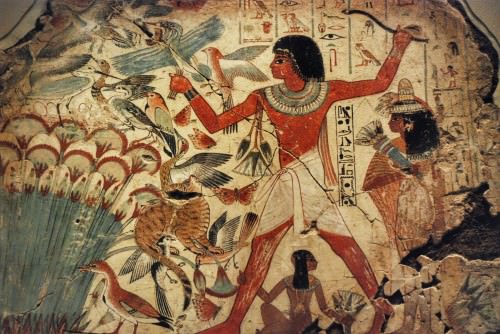
Egyptian Hunting in the Marshes
Gardens and simple home adornments were highly prized by the Egyptians. A home garden was important for sustenance but also provided pleasure in tending to one's own crop. The labourers in the fields never worked their own crop and so their individual garden was a place of pride in producing something of their own, grown from their own soil. This soil, again, would be their eternal home after they left their bodies and so was greatly valued. A tomb inscription from 1400 BCE reads, “May I walk every day on the banks of the water, may my soul rest on the branches of the trees which I planted, may I refresh myself under the shadow of my sycamore” in referencing the eternal aspect of the daily surroundings of every Egyptian. After death, one would still enjoy one's own particular sycamore tree, one's own daily walk by the water, in an eternal land of peace granted to those of Egypt by the gods they gratefully revered.
LICENSE:
Article based on information obtained from these sources:with permission from the Website Ancient History Encyclopedia
Content is available under License Creative Commons: Attribution-NonCommercial-ShareAlike 3.0 Unported. CC-BY-NC-SA License